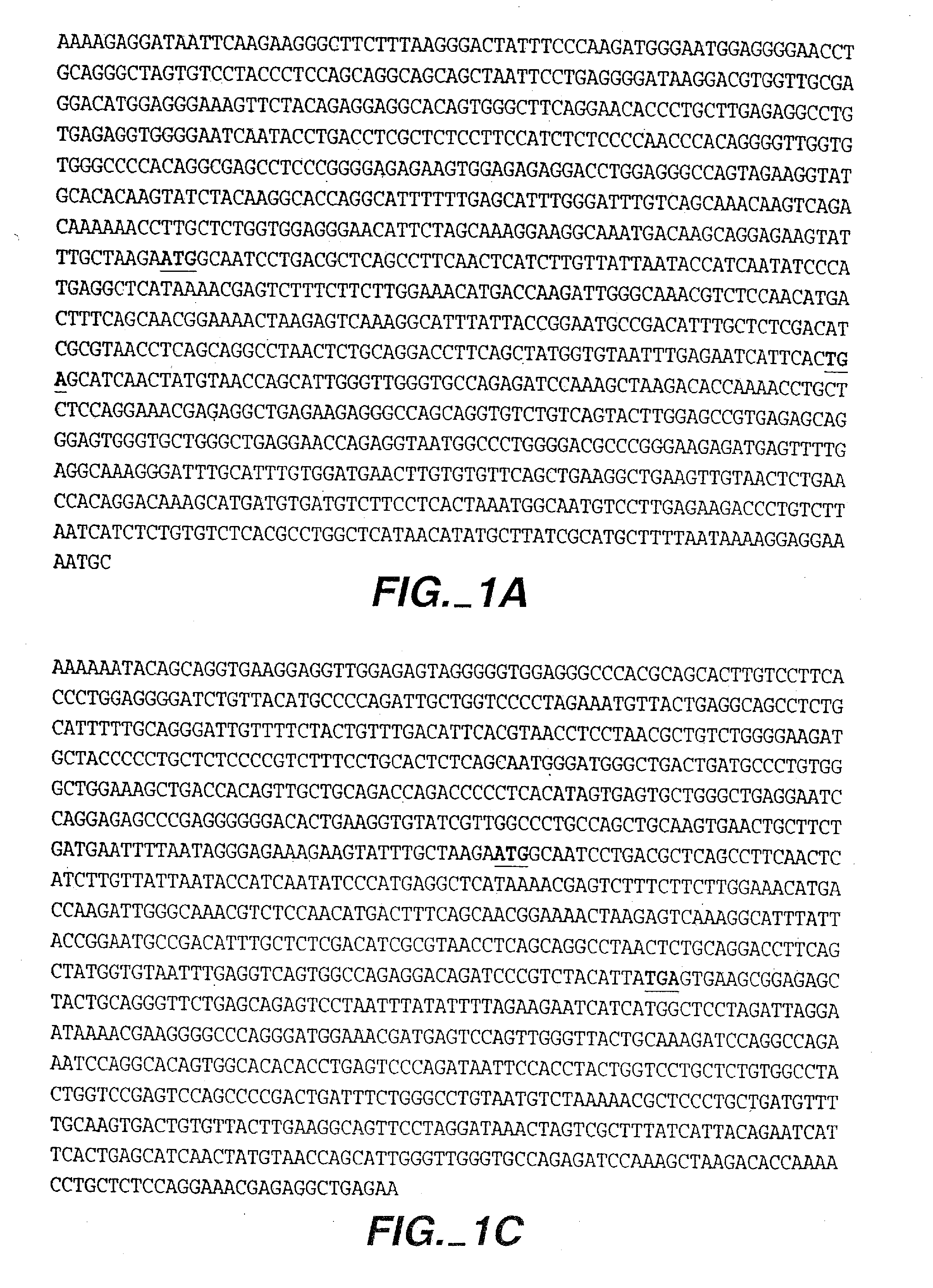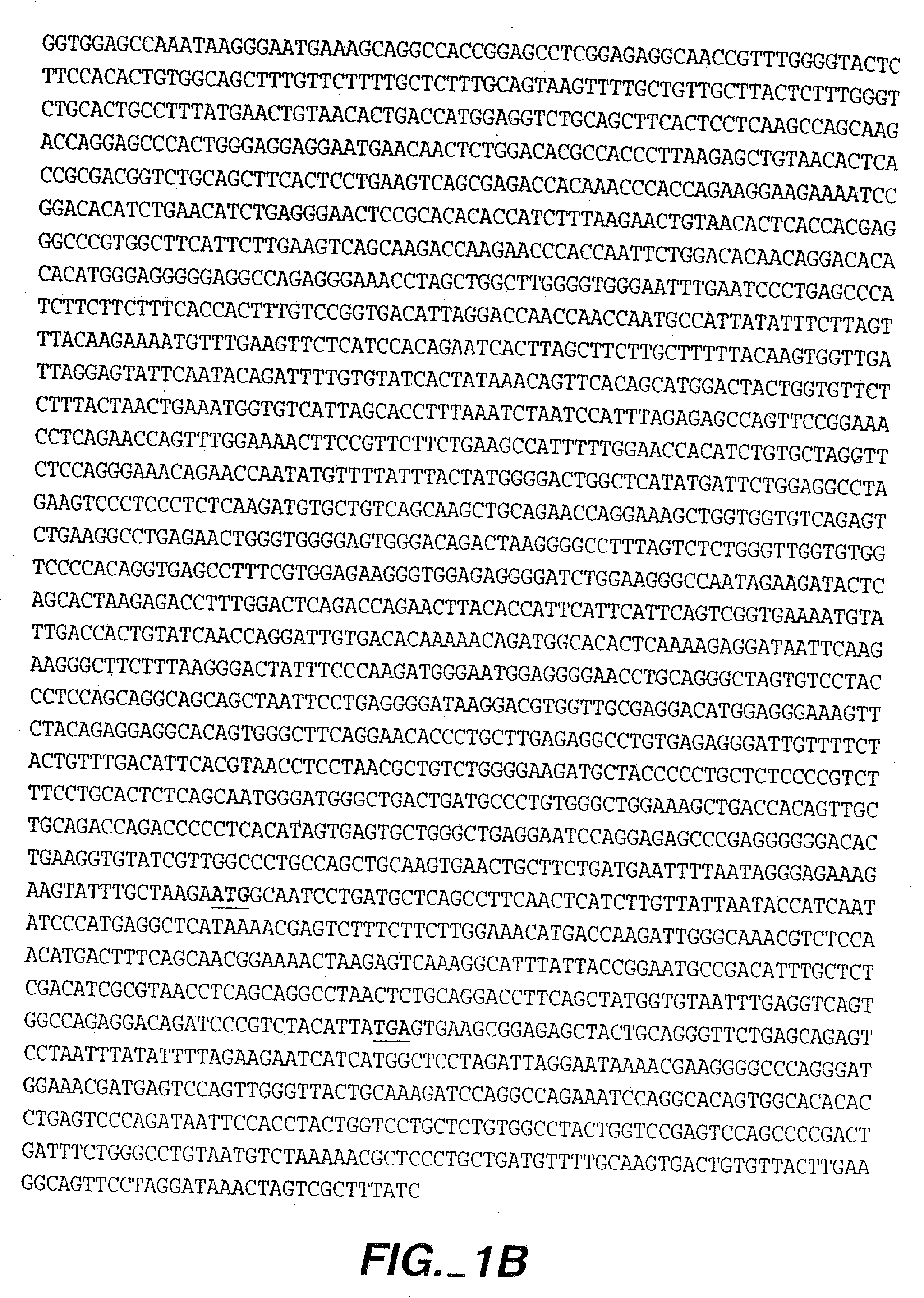Ns4 nucleic acids and polypeptides and methods of use for the treatment of body weight disorders
a nucleic acid and polypeptide technology, applied in the field of ns4 genes, can solve the problems of reducing causing negative nitrogen balance, and causing catabolism of body protein stores, so as to reduce the total body weight of obese subjects, reduce the weight of obese persons, and improve the effect of health
- Summary
- Abstract
- Description
- Claims
- Application Information
AI Technical Summary
Benefits of technology
Problems solved by technology
Method used
Image
Examples
example 1
Isolation of cDNA Clones Encoding a Human NS4 (DNA149986-2883 and DNA149995-2871)
[0414] A sequence encoding the OPG ligand (without signal sequence) (amino acids 69-317; see Anderson et al., Nature, 390:175 (1997)) was used to search sequence databases. The databases included public databases (e.g., GenBank). The search was performed using the computer program BLAST or BLAST2 [Altschul et al., Methods in Enzymology, 266:460-480 (1996)], and it led to the identification of a genomic sequence (AC010969). The genomic DNA sequence was analyzed using the gene prediction program GENSCAN, licensed from Stanford University. GENSCAN analysis predicts gene coding regions, creating DNA sequences with potential open reading frames. A consensus DNA sequence was assembled (DNA143746) which exhibited correspondence to nucleotides 64070-64243 of the genonimic DNA sequence AC010969. In a translated reading frame, DNA143746 comprises a region of 57 contiguous residues which shows an approximate 60% ...
example 2
Use of NS4 Polynucleotides as Hybridization Probes
[0424] The following method describes use of a nucleotide sequence encoding SRT as a hybridization probe.
[0425] DNA comprising the coding sequence of full-length or mature SRT is employed as a probe to screen for homologous DNAs (such as those encoding naturally-occurring variants of SRT) in human tissue cDNA libraries or human tissue genomic libraries.
[0426] Hybridization and washing of filters containing either library DNAs is performed under the following high stringency conditions. Hybridization of radiolabeled SRT-derived probe to the filters is performed in a solution of 50% formamide, 5×SSC, 0.1% SDS, 0.1% sodium pyrophosphate, 50 mM sodium phosphate, pH 6.8, 2× Denhardt's solution, and 10% dextran sulfate at 42° C. for 20 hours. Washing of the filters is performed in an aqueous solution of 0.1×SSC and 0.1% SDS at 42° C.
[0427] DNAs having a desired sequence identity with the DNA encoding full-length native sequence SRT can...
example 3
Expression of NS4 in E. coli
[0429] This example illustrates preparation of an unglycosylated form of NS4 by recombinant expression in E. coli.
[0430] The DNA sequence encoding NS4 is initially amplified using selected PCR primers. The primers should contain restriction enzyme sites which correspond to the restriction enzyme sites on the selected expression vector. A variety of expression vectors may be employed. An example of a suitable vector is pBR322 (derived from E. coli; see Bolivar et al., Gene 2:95 (1977)) which contains genes for ampicillin and tetracycline resistance. The vector is digested with restriction enzyme and dephosphorylated. The PCR amplified sequences are then ligated into the vector. The vector will preferably include sequences which encode for an antibiotic resistance gene, a trp promoter, a polyhis leader (including the first six STII codons, polyhis sequence, and enterokinase cleavage site), the NS4 coding region, lambda transcriptional terminator, and an a...
PUM
| Property | Measurement | Unit |
|---|---|---|
| Fraction | aaaaa | aaaaa |
| Electric charge | aaaaa | aaaaa |
| Electric charge | aaaaa | aaaaa |
Abstract
Description
Claims
Application Information
 Login to View More
Login to View More - R&D
- Intellectual Property
- Life Sciences
- Materials
- Tech Scout
- Unparalleled Data Quality
- Higher Quality Content
- 60% Fewer Hallucinations
Browse by: Latest US Patents, China's latest patents, Technical Efficacy Thesaurus, Application Domain, Technology Topic, Popular Technical Reports.
© 2025 PatSnap. All rights reserved.Legal|Privacy policy|Modern Slavery Act Transparency Statement|Sitemap|About US| Contact US: help@patsnap.com



